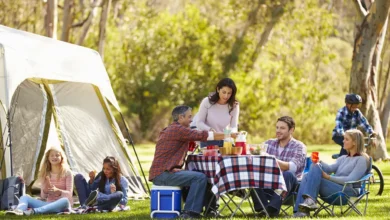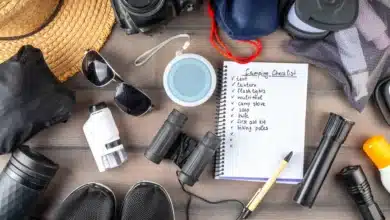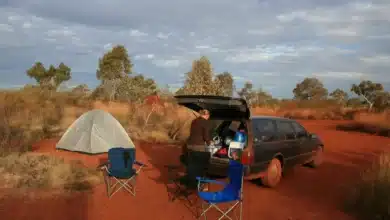Is it Safe to Use a Fire Pit Under a Canopy?
Is it Safe to Use a Fire Pit Under a Canopy During Rain?
Using a fire pit in an open space can be challenging during rain. Is it safe to use a fire pit under a canopy? Let us answer this question below
As a teenager, I would always rush to my uncle’s backyard because I loved sitting next to a lit fire. And now, when I am grown up, I can only reminisce about the old times with fire pits, more so because people refrain from sitting across a fire pit when there are indications that it might rain since there is no way to cover your head.
Or is there?
Many tent owners have started customizing canopies to shelter their fire pit. This is especially beneficial in camping trips, home gardens, or outdoor areas where you expect a lot of rainfall but love going.
So, if you are someone who likes to spend time around a fire pit with close friends, read on how you can use a water-proof canopy with all safety precautions to enjoy your next camping trip.
What Kind of Canopy is Used for a Fire Pit?
Unlike a regular canopy, some manufacturers make robust canopies that can withstand both harsh weather and the heat of a fire. For the purpose of using them for fire pits, these are made from materials that can block both heat and water.
There are a few things that you should consider before trying to install a canopy for using it over a fire pit. This article covers those parameters in detail to help you buy the most efficient and versatile one.
Weather Conditions
Whether you are investing in a large-size or even standard-size canopy, you must follow up with the current weather conditions. This is the most important thing for restricted zones or areas with dry climates where building a fire pit can do more harm than good.
It is advisable that you should not light up a fire in excessively dry conditions as burning flames can quickly spread in such regions. Also, you should always look for signs or boards that restrict the use of fire pits. Most of the states or cities in America impose strict penalties if you light a fire pit in a restricted area.
Canopy Structure
The canopy structure should always align with the area, size of the fire pit, and long usage. So, if you are on a hunt for one of the most versatile canopies, you must look after the following particulars.
Canopy Dimensions:
With plenty of options available with different canopy sizes, you must confirm if:
- Canopy size suits the area size number of people and has additional space for seating arrangements.
- One must also look for small and medium-sized canopies for small yards and large ones for large patios.
Materials to use:
The materials used in the overhead canopy should align with the very purpose of purchasing it. For attaining maximum benefits of using a canopy over a fire pit, you should see if the canopy is robust, fire-safe, water-proof, and heat resistant.
The top of the canopy should have strong fabric that can stay intact for long hours of use. Most often, canopy makers advise avoiding wooden gazebos or plastic tents that can draw fire to their surface.
The pillars of the canopy can be any metal, stone, or bricks that can absorb direct heat coming out of the fire pits.
Ventilation System:
Many canopies sold in the market come with an appropriate size opening to let out the fire smoke. The absence of any opening can crowd the toxic air inside the tent and can cause many health problems. For this reason, a canopy must have proper ventilation either on the top or to its sides.
Is it Safe to Use a Fire Pit Under a Canopy & Distance From Nearby Objects
For avoiding the likelihood of fire accidents or accidental fire damage, it is important to take note of the distance while placing a fire pit:
- There should be a minimum distance of about 16-20 feet from where you are setting up a fire pit to any other camper’s site. This will help you to avoid conflicts due to smoke fuming out on others’ property.
- You should always light a fire pit only after the written approval from your state’s fire regulatory boards. As per the changing norms, there should be an appropriate distance to place a fire pit to ensure maximum fire safety.
- The ceiling height is another most important parameter that will help you to trust canopies for fire lightning purposes. For the best safety, manufacturers suggest that one should always invest in a tall canopy. A minimum of 10 feet ceiling height from your fire pit will ensure that your fire will cause no harm.
With a low-height canopy, the heat of the fire can easily reach the ceiling and cause cracks, burn, or stain the ceilings, altogether.
- If you are going to use any flammable objects within your tent, try to keep them at a comfortable distance. This is especially relevant if you are using wooden chairs, paints, tires, or any other objects that can catch fire in seconds.
SIs it Safe to Use a Fire Pit Under a Canopy & Source Of Fire
The source of fire for fire pits should be safe, abundant, and can be used at all times. For this purpose, there are two types of fire sources:
Woodfire Burning:
With a wood-based fire source, one can easily enjoy the bonfire if you are also planning to cook meals at the same time. However, the wooden fire pit causes a lot of black smoke, which can irritate the skin even if you opt for a large-size canopy.
After long hours of use, there is a high chance that these wooden fire pits can turn down or may scrap after a while. Additionally, wooden fire pits tend to produce flying embers or carbon particles that contain carbon monoxide.
When released in the air, these carbon molecules can even damage other objects. So, while using a wood fire pit, it is advisable that you cover it with a fire screen. This will automatically hold the toxic carbons and prevent the space from any hazardous reactions.
Propane or Natural Gas:
Available in households and other commercials, the use of natural gas for lighting a fire pit is extremely safe. Propane or any natural gas is odor-free and fumes no smoke, making it an ultimate priority used in the fire pits.
However, one should still be careful while using a natural gas fire pit as it can spark intense heat, stronger than wood-based fire pits.
With regard to using this fire pit, it is recommended that you take a few precautions like:
Ensure to use the natural gas fire pits with all the major fire-safety standards by checking up with manufacturers’ clearances.
Also, you must have written permission from city authorities to use a propane or any natural gas fire pit. This will allow you to enjoy peaceful leisure with your friends or family. Check for the gas hose leakages to prevent the fire from knocking down your property.
Is it Safe to Use a Fire Pit Under a Canopy & Materials for Fire Pit
The materials used in the fire pit should also be taken care of when you choose to plan for a camping trip.
- Avoid wood or vinyl materials that can attract fire and spread up to a long distance. For using safe materials under your fire pit, choose materials like metal, stone, or bricks that can amplify heat without causing any harm.
- The contents used in your fire pit should be at par with the height of the fire pit. Overloading your fire pit can damage the nearby objects at a quick pace and will more likely cause it to fall.
- The base of your fire pit should be steady and above the ground. The raised fire pit will protect the ground from flames or heat.
Is it Safe to Use a Fire Pit Under a Canopy & Safety Precautions to Consider
While many believe that using fire under a tent is not a good idea. As the fire can easily burn the tent fabric or can trap the space. With fire safety precautions, you can still consider using a fire pit under a canopy.
- Follow the instruction manual given by your manufacturer. Also, ask for prior permission as some cities do restrict the use of fire pits.
- Keep a fire extinguisher alongside to avoid any mishappenings.
- Limit the use of fire pits in areas with trees, leaves, or any flammable objects.
- Keep safe seating arrangements by limiting the use of wooden chairs and allowing more space for metal chairs.
A Few Final Words
Whether it is camping around with a bonfire, hosting a barbeque grill (click link to see a great portable one), or enjoying the cozy winters, the fire lighting can be fascinating. This is more so when the winds and snow untimely knock the changing weather.
The use of a canopy is the most preferred option for sheltering your fire without needing to remove the canopy. This, in turn, serves the dual purpose: leisure to enjoy the firepit and the comfort of shelter.
In a nutshell, it is safe to build up a fire pit under a canopy when you follow the fire safety rules and precautions to avoid the worst-case scenario. If you like this article, please share your thoughts in the comment section. Also, feel free to share the article with your friends and family.








